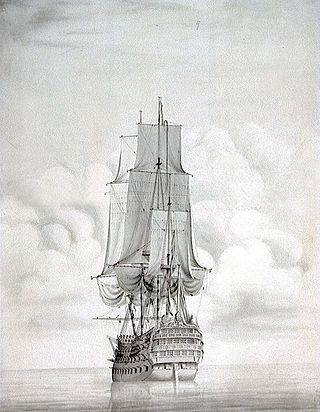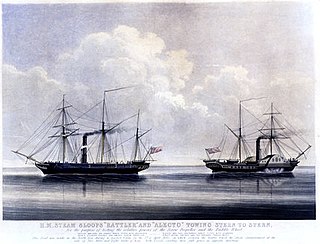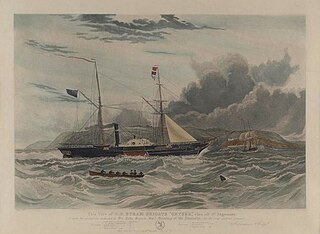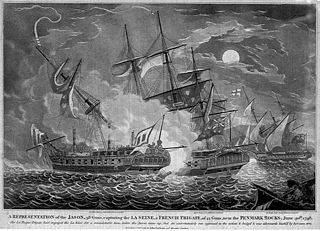
HMS Vanguard was a 90-gun second-rate ship of the line of the Royal Navy, built at Portsmouth Dockyard and launched in 1678.
Five Royal Navy ships have had the name of HMS Culloden, after the battle of Culloden which took place in Scotland in 1746 and saw the defeat of the Jacobite rising.

HMS Discovery was the consort ship of James Cook's third expedition to the Pacific Ocean in 1776–1780. Like Cook's other ships, Discovery was a Whitby-built collier originally named Diligence when she was built in 1774. Purchased in 1775, the vessel was measured at 299 tons burthen. Originally a brig, Cook had her changed to a full-rigged ship. She was commanded by Charles Clerke, who had previously served on Cook's first two expeditions, and had a complement of 70. After Cook was killed in a skirmish following his attempted kidnapping of Hawaiian leader Kalaniʻōpuʻu, Clerke transferred to the expedition's flagship HMS Resolution and John Gore assumed command of Discovery. She returned to Britain under the command of Lieutenant James King, arriving back on 4 October 1780.
Seven ships of the United Kingdom's Royal Navy have been called HMS Pallas. See Pallas (disambiguation) for various figures called "Pallas" in Greek mythology.

HMS Apollo, the third ship of the Royal Navy to be named for the Greek god Apollo, was a 38-gun Artois-class fifth rate frigate of the Royal Navy. She served during the French Revolutionary Wars, but her career ended after just four years in service when she was wrecked on the Haak sands off the Dutch coast.

HMS Rattler was a 9-gun steam screw sloop of the Royal Navy, and one of the first British warships to be completed with screw propulsion. She was originally ordered as a paddle wheel 4-gun steam vessel from Sheerness Dockyard on 12 March 1841. She was reordered on 24 February 1842 as a propeller type 9-gun sloop from HM Royal Dockyard, Sheerness, as a new vessel. William Symonds had redesigned the ship as a screw propeller driven vessel.

HMS Northumberland was a 70-gun third-rate ship of the line of the Royal Navy, built at Deptford Dockyard and launched in 1705.
HMS Trident was an iron paddle sloop built for the Royal Navy by Ditchburn & Mare in 1845 at Leamouth, London. She served in the Mediterranean, off West Africa and in the South Atlantic, and was broken up in 1866.
Ten ships of the Royal Navy have borne the name HMS Woolwich, after the port town and naval base of Woolwich. An eleventh was planned but entered service under a different name.
Seven ships of the Royal Navy have borne the name HMS Hazard:

HMS Fisgard was a 46-gun fifth rate Leda-class frigate of the Royal Navy. She spent sixty years in service on a variety of duties.

HMS Grafton was a 70-gun third rate ship of the line of the Royal Navy. She was built by Swallow and Fowler, of Limehouse, London, to the dimensions of the 1706 Establishment, and was launched on 9 August 1709.

HMS Amphion was a 36-gun wooden hulled screw frigate of the Royal Navy. She was initially ordered as a sail powered ship, but later reordered as a prototype screw frigate conversion.

HMS Geyser was a Driver-class wooden paddle sloop of the Royal Navy constructed in 1841 and broken up in 1866.

HMS Blossom was an 18-gun Cormorant-class sloop-of-war. She was built in 1806 and is best known for the 1825–1828 expedition under Captain Beechey to the Pacific Ocean. She explored as far north as Point Barrow, Alaska, the furthest point into the Arctic any non-Inuit had been at the time. She was finally broken up in 1848.

HMS Jason was a 38-gun Artois-class fifth-rate frigate of the Royal Navy. She served during the French Revolutionary Wars, but her career came to an end after just four years in service when she struck an uncharted rock off Brest and sank on 13 October 1798. She had already had an eventful career, and was involved in several engagements with French vessels.

HMS Charles Galley was a 32–gun fifth rate of the Royal Navy built at Woolwich Dockyard and launched in 1676. She was rebuilt in 1693, and again at Deptford Dockyard in 1710. She was renamed HMS Torrington after a third rebuild in 1729, and was hulked in 1740. She was finally sold on 12 July 1744.

HMS Royal Albert was a 121 gun three-decker ship of the Royal Navy launched in 1854 at Woolwich Dockyard. She had originally been designed as a sailing ship but was converted to screw propulsion while still under construction.

HMS Niger was originally slated to be built as a Sampson designed sloop; however, she was ordered as a First-Class sloop with screw propulsion on 20 February 1845 to be built at Woolwich Dockyard, along the design developed by Oliver Lang and with a hull like the Basilisk designed paddle sloops. Her armament and engine were to be like the Encounter Design building at Pembroke. A second vessel (Florentia) was ordered on 26 March 1846 but after her keel was laid at Pembroke Dockyard, her construction was suspended on 6 October 1846 then cancelled three years later, on 22 May 1849. Niger She conducted important propulsion trials, finally proving the superiority of screw propulsion and served in West Africa, the Crimea, China, the East Indies and Australia. She took part in the New Zealand wars in 1860 and was sold for breaking in 1869.

HMS Chatham was a 74-gun third-rate ship of the line of the Royal Navy. She had been planned as Royal-Hollandais for the French Navy, but was captured while under construction during the Walcheren Campaign.
















